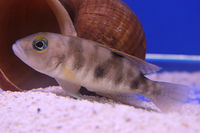Difference between revisions of "Neolamprologus boulengeri"
From The Aquarium Wiki
m |
|||
| (One intermediate revision by the same user not shown) | |||
| Line 38: | Line 38: | ||
:Endemic to Lake Tanganyika. | :Endemic to Lake Tanganyika. | ||
| + | == General care == | ||
| + | : Setup the aquarium with plenty of rocks, and visual barriers to help mitigate territorial disputes. Keep in groups of 4+ . A large aquarium (15 gallons<) is usually required for a group of 4-5. If a group is well aquatinted, and have been kept in smaller aquariums (i.e a shop tank) without any trouble, one could keep a quartet in an aquarium of around 10 gallons (with some clever aqua scaling and aquarium design. However, this is an exception rather than a rule, so ideally shoot for 20 gallons. | ||
| + | |||
| + | == Feeding == | ||
| + | :Tank bred specimens readily accept frozen, live or pellet foods. Life foods are ideal, however not entirely necessary. Good live foods include bloodworms, tubifex and artemia (brine shrimp). | ||
== Sexing == | == Sexing == | ||
Latest revision as of 13:16, 12 March 2022
Boulenger's Cichlid
Neolamprologus boulengeri
57 Litres (15 US G.)
5.1-7.6cm (2-3 ")
Freshwater
7.5 - 8.5
24 -26 °C (75.2-78.8°F)
6-10 °d
1:1 M:F
3-5 years
Family
Cichlidae
Error creating thumbnail: Unable to save thumbnail to destination |
You can contribute to the Aquarium Wiki by expanding this article. Dont be shy!. |
Origin[edit]
- Endemic to Lake Tanganyika.
General care[edit]
- Setup the aquarium with plenty of rocks, and visual barriers to help mitigate territorial disputes. Keep in groups of 4+ . A large aquarium (15 gallons<) is usually required for a group of 4-5. If a group is well aquatinted, and have been kept in smaller aquariums (i.e a shop tank) without any trouble, one could keep a quartet in an aquarium of around 10 gallons (with some clever aqua scaling and aquarium design. However, this is an exception rather than a rule, so ideally shoot for 20 gallons.
Feeding[edit]
- Tank bred specimens readily accept frozen, live or pellet foods. Life foods are ideal, however not entirely necessary. Good live foods include bloodworms, tubifex and artemia (brine shrimp).
Sexing[edit]
- Females are smaller than the males.
Pictures[edit]
External links[edit]
- Fishbase (Mirrors: Error creating thumbnail: Unable to save thumbnail to destination)
